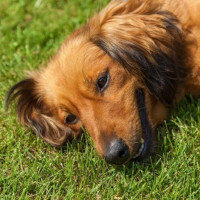Appearance of the Mini English Cocker
|
| The Mini English Cocker can vary in appearance depending on which of the parents' genetics is most dominant. Even puppies from the same litter can vary, some looking more like English Cocker Spaniels with soft, wavy coats and feathers on ears, tail and legs. Other puppies may resemble the Dachshund, looking more elegant, longer and with a straight or stiff coat. It's pure luck of the draw as to what the puppies will look like, but one thing is certain and that is their soulful eyes, sturdy little body and affectionate nature. Short legs with well rounded paws, a rounded head with a slightly pointed muzzle and long, floppy ears are the Mini English Cocker's trademark. A long tail held at mid-height, which can be fluffy or smooth, and dark eyes and nose, as well as a combination of colors, often two-tone, offer many attractive features. |
Temperament of the Mini English Cocker
|
| Cute and adorable, but also clever and intelligent, Mini English Cockers also have a stubborn side that can be overcome with patience and kindness. These dogs love being with their family and are definitely indoor dogs. Although they love to explore the outdoors, they seek human contact. Early socialization with people and other dogs will enable them to become well-balanced dogs with pleasant personalities. They are generally calm and quiet dogs, making them ideal for a pet. They have a strong hunting instinct, a gift from their parent breeds, and may be inclined to chase anything that gets away from them. The use of a leash is therefore important when you're out and about. Training and early socialization will help overcome this, especially if they are purchased with other pets. They love games that challenge them mentally, and are happy dogs who love nothing more than snuggling up to you and the family. The Mini English Cocker can be entertaining and funny, or calm and somber. Although they may inherit the lively, courageous nature of their fearless ancestors, the mixed breed generally tempers this trait and is described as a mild-tempered dog. |
Needs and activities of the Mini English Cocker
|
| The Mini English Cocker has moderate exercise requirements, making it ideal for apartment living, and the fact that they are not barkers is a bonus. A walk around the neighborhood, or an hour or two at the dog park will burn off their energy and engage their inquisitive nature. Some days, they'll just want to stay by your side, enjoying the attention they get. Other days, they'll disappear after an interesting scent, so if you're in an unfenced area, a leash is advisable. They'll happily walk or trot alongside you on your daily outings, or sit and contemplate life while you sip your coffee. At home, they're more interested in cuddling up with the family, and appreciate any petting and attention you can give them. |
Maintenance of the Mini English Cocker
|
| The Mini English Cocker is a medium-maintenance dog, requiring brushing twice a week to get rid of loose hair and prevent matting. They are not great excretors, but good brushing will keep the coat shiny and looking its best. Because they have floppy ears, be sure to check for accumulated dirt and if so, wipe them gently with a damp cloth to clean them. Never push anything into the ear canal, as this could damage your dog's hearing. Inflammation can start in the warm, moist environment of the ear, so it's a good idea to include this maintenance as a regular task. Brushing your dog's teeth will ensure good hygiene and prevent doggy breath, keeping teeth strong and healthy. As for bathing, they only need it if they've been rolling around in mud or something a bit smelly. Use a mild dog shampoo to protect their coat and skin. |









 English (United Kingdom)
English (United Kingdom)